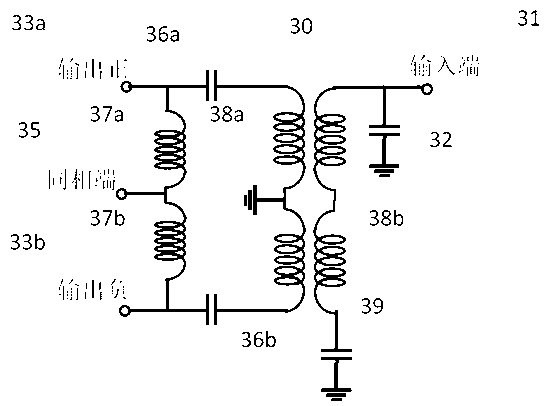Passive three-balanced frequency converter
A frequency converter, balanced technology, applied in the field of passive three-balanced frequency converter, can solve the problems of reducing the operating frequency range of the diode loop, it is difficult to balance signal transmission and working conditions, and cannot meet the requirements of low-loss frequency conversion, etc., to achieve a simple structure , Good clutter filtering, small footprint
- Summary
- Abstract
- Description
- Claims
- Application Information
AI Technical Summary
Problems solved by technology
Method used
Image
Examples
Embodiment Construction
[0022] Such as figure 2, The cathodes and anodes of the four diodes D1, D2, D3, and D4 are connected end to end in turn to form a closed loop. Among the three signal conversion baluns, the local oscillator balun 10 is provided with four ports: an input terminal 22 connected to the local oscillator signal, two balanced differential signal output terminals 24a (LO+) and 24b ( LO-) and an in-phase signal output terminal 26, the in-phase signal output terminal is in the middle position of the two symmetrical balanced differential signal output terminals, according to the required local oscillator frequency and output frequency, it is relative to the two balanced differential signal output terminals. The signal output terminal belongs to the common point MO1 of virtual zero potential. The input balun 12 has four ports: an input terminal 18 connected to the frequency-converted signal, two balanced differential signal output terminals 28a and 28b with the same amplitude but opposit...
PUM
 Login to View More
Login to View More Abstract
Description
Claims
Application Information
 Login to View More
Login to View More - R&D
- Intellectual Property
- Life Sciences
- Materials
- Tech Scout
- Unparalleled Data Quality
- Higher Quality Content
- 60% Fewer Hallucinations
Browse by: Latest US Patents, China's latest patents, Technical Efficacy Thesaurus, Application Domain, Technology Topic, Popular Technical Reports.
© 2025 PatSnap. All rights reserved.Legal|Privacy policy|Modern Slavery Act Transparency Statement|Sitemap|About US| Contact US: help@patsnap.com



